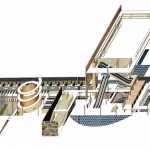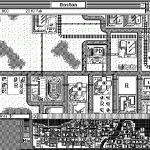Der Spiegel recently invited architect Rem Koolhaas to tour HafenCity (Europe’s largest urban redevelopment project) and to show him the new Spiegel headquarters building, a project by renowned Danish firm Henning Larsen.


Koolhaas interviews with Der Spiegel (2006 and 2008) are usually kind of funny, as the architect loves to titillate the unhidden moralism and insecurities of the German.
In fact, interviewing Koolhaas (again), means for the Spiegel to be addressed by phrases like this: “I get the feeling that what you need from me isn’t so much an interview as an hour of therapy”, and the journalist can’t help confessing his regret that “the (new) building is more powerful than those working inside it.”
Apart from mundanities, some segments of the dialogue thoroughly paint the issues of contemporary generic cities:

SPIEGEL: In “The Generic City,” you ask whether it might not be intentional that our cities are becoming increasingly similar and faceless.
Koolhaas: Yes. And the answer could be: The traditional city is very much occupied by rules and codes of behavior. But the generic city is free of established patterns and expectations. These are cities that make no demands and, consequently, create freedom. Some 80 percent of the population of a city like Dubai consists of immigrants, while in Amsterdam it is 40 percent. I believe that it’s easier for these demographic groups to walk through Dubai, Singapore or HafenCity than through beautiful medieval city centers. For these people, (the latter) exude nothing but exclusion and rejection. In an age of mass immigration, a mass similarity of cities might just be inevitable. These cities function like airports in which the same shops are always in the same places. Everything is defined by function, and nothing by history. This can also be liberating.
Koolhaas: Soulless means that it’s difficult to determine what a building wants to convey. It is difficult to pinpoint the elements that make the difference. In my essay “The Generic City,” I tried to get to the bottom of this soullessness, though in terms of entire cities rather than buildings. These days, we’re building assembly-line cities and assembly-line buildings, standardized buildings and cities.
…and of weakened ambitions of today’s architecture:

SPIEGEL: One could also describe the face of our cities as the face of neoliberalism.
Koolhaas: Under neoliberalism, architecture lost its role as the decisive and fundamental articulation of a society.
SPIEGEL: How does a society articulate itself?
Koolhaas: Take, for example, the prefabricated building. No matter how misguided this ultimately turned out to be, it actually was a very clear articulation. But neoliberalism has turned architecture into a “cherry on the cake” affair. The Elbphilharmonie is a perfect example: It’s icing on the cake. I’m not saying that neoliberalism has destroyed architecture. But it has assigned it a new role and limited its range.
Through the Metabolist project Koolhaas advocates a return to a greater government control:
Koolhaas: That’s right. The state wasn’t always the hopeless and powerless entity it is often perceived to be in the West today. We learn this from the Metabolists, who the government engaged in 1960 to combat their country’s structural weaknesses: earthquakes, tsunamis, the parceling of the country. Another interesting thing about the Metabolist movement is the fact that, despite being great individualists, its members acted as a group. Today, this possibility no longer exists. The compulsion to compete has isolated architects.
But the conversation soon shifts to the controversies of dealing with authoritarianism:
Koolhaas: (…) I’m not pessimistic when it comes to the prospects for the West, for democratic societies, and the ability to build strong statements here. The only reason I chose not to take part in the Ground Zero competition was that the project’s connection to the past was too clear for my taste. There is more willingness to experiment in China. So much is being built there — entire cities! — that greater risks have to be taken. There, failure is not a disaster.
And even one as cynical as Koolhaas can’t help complaining for the inherent frustrations of the profession:
Koolhaas: As an architect, one operates in an unstable ideological environment. What is true today can be completely wrong in five years, and in 25 years it’s most certainly wrong. Ridiculous.
An appropriate ending of the therapy: an odd yet “zeitgesty” declaration, about the new Spiegel headqurter:
Koolhaas: You’ll get used to it. But I believe you have to conquer the lobby. Buy two rugs, sew the two rugs together, then buy a third one and declare the lobby occupied. Occupy SPIEGEL!

Full interview here; German original here.
Above: pictures are from the article.





Leave a Reply